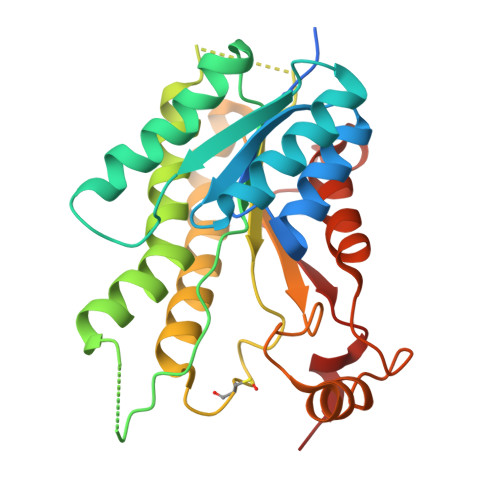Design of 2-Aminobenzothiazole Derivatives Targeting Trypanosomatid PTR1 by a Multidisciplinary Fragment Hybridization Approach.
Panecka-Hofman, J., Linciano, P., Pohner, I., Dyguda-Kazimierowicz, E., Jedwabny, W., Landi, G., Santarem, N., Witt, G., Ellinger, B., Kuzikov, M., Luciani, R., Ferrari, S., Aiello, D., Mangani, S., Pozzi, C., Cordeiro-da-Silva, A., Gul, S., Costi, M.P., Wade, R.C.(2025) J Med Chem 68: 20595-20618
- PubMed: 41026998
- DOI: https://doi.org/10.1021/acs.jmedchem.5c01799
- Primary Citation of Related Structures:
9HUP, 9HUT, 9HUU, 9HUV, 9HUW - PubMed Abstract:
Pteridine reductase 1 (PTR1) is a folate pathway enzyme essential for pathogenic trypanosomatids and a promising drug target for diseases such as sleeping sickness and leishmaniasis. Previous studies have shown that the 2-aminobenzothiazole moiety targets the PTR1 biopterin pocket, while 3,4-dichlorophenyl-containing compounds, such as I bind a different region of the Trypanosoma brucei PTR1 ( Tb PTR1) pocket. This study combines both moieties via various linkers, creating two compound series screened in silico against Tb PTR1 and Leishmania major PTR1 ( Lm PTR1). In the first series, five compounds were synthesized, and 1a and 1b emerged as potent Tb PTR1 inhibitors, with 1b also being active against Lm PTR1 and moderately effective against Leishmania infantum . Furthermore, structure-activity relationship analysis, supported by quantum calculations and crystallography, revealed meta-halogenation to be more favorable than para, although single halogenation reduced antiparasite effects. Our fragment hybridization approach led to less toxic, more effective compounds than I .
- Molecular and Cellular Modeling Group, Heidelberg Institute for Theoretical Studies (HITS), D-69118 Heidelberg, Germany.
Organizational Affiliation:






















